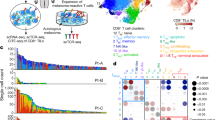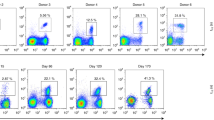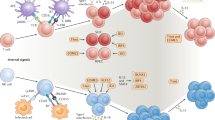Abstract
THE specificity of cytotoxic T lymphocytes against influenza virus-infected target cells has been investigated in primary responses in vivo1–5 and in secondary responses both in vivo1 and in vitro2,4,6. Cold target inhibition techniques have been used to analyse the specificity of responses but this approach has not produced total agreement between all workers2,3,5,6. By analogy with antibody production, the most effective way of analysing the specificity of a response is to assess the specificity of a representative sample of monoclonal cytotoxic lymphocytes (CL). To this end we have devised culture conditions whereby individual clones of CL may be generated in a primary antiviral response against influenza A-infected cells. Our work shows that a clonal analysis of virus-induced cytotoxic T cells is feasible. The analysis of individual clones will allow any cross-reactivity towards cells infected with different strains of virus, for example, to be attributed to cross-reactive clones or the existence of several clones each with unique specificity. We report here that in establishing this approach, we have detected several clones which lyse uninfected target cells and we have studied the time of appearance of such clones.
This is a preview of subscription content, access via your institution
Access options
Subscribe to this journal
Receive 51 print issues and online access
$199.00 per year
only $3.90 per issue
Buy this article
- Purchase on Springer Link
- Instant access to full article PDF
Prices may be subject to local taxes which are calculated during checkout
Similar content being viewed by others
References
Doherty, P. C., Iffros, R. B. & Bennick, J. Proc. natn. Acad. Sci. U.S.A. 74, 1209–1213 (1977).
Braciale, T. J. Cell. Immun. 33, 423–436 (1977).
Ennis, F. A., Martin, W. J., Verbonitz, M. W. & Butchko, G. M. Proc. natn. Acad. Sci. U.S.A. 74, 3006–3010 (1977).
Yap, K. L. & Ada, G. L. Immunology 32, 151–159 (1977).
Effros, R. B., Doherty, P. C., Gerhard, W. C. & Bennick, J. J. exp. Med. 145, 557–568 (1977).
Zweerink, H. J., Askonas, B. A., Millican, D., Courtneidge, S. A. & Skehel, J. J. Eur. J. Immun. 7, 630–635 (1977).
Marbrook, J. & Haskill, J. S. Cell. Immun. 13, 12–21 (1974).
Skinner, M. A. & Marbrook, J. J. exp. Med. 143, 1562–1567 (1976).
Ching, L. M., Marbrook, J. & Walker, K. Z. Cell. Immun. 31, 284–292 (1977).
Quintáns, T. & Lefkovits, I. Eur. J. Immun. 3, 392–397 (1973).
Cantor, H. & Boyse, E. A. Cold Spring Harb. Symp. quant. Biol. 41, 23–32 (1976).
Ching, L. M. & Marbrook, J. (in preparation).
Marbrook, J. Lancet ii, 1279 (1967).
Pfizenmaier, K., Trostmann, H., Röllinghoff, M. & Wagner, H. Nature 258, 238–240 (1975).
Butchko, G. M., Armstrong, R. B., Martin, W. J. & Ennis, F. A. Nature 271, 66–67 (1978).
Author information
Authors and Affiliations
Rights and permissions
About this article
Cite this article
KOMATSU, Y., NAWA, Y., BELLAMY, A. et al. Clones of cytotoxic lymphocytes can recognise uninfected cells in a primary response against influenza virus. Nature 274, 802–804 (1978). https://doi.org/10.1038/274802a0
Received:
Accepted:
Issue Date:
DOI: https://doi.org/10.1038/274802a0
Comments
By submitting a comment you agree to abide by our Terms and Community Guidelines. If you find something abusive or that does not comply with our terms or guidelines please flag it as inappropriate.



